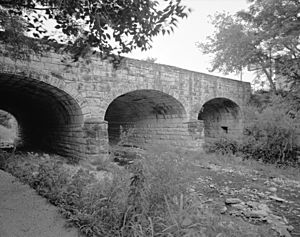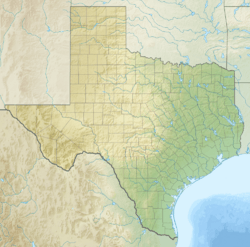West Sixth Street Bridge facts for kids
Quick facts for kids West Sixth Street Bridge |
|
|---|---|

Southwest view in the Historic American Engineering Record
|
|
| Carries | West Sixth Street |
| Crosses | Shoal Creek |
| Locale | Austin, Texas United States |
| Owner | City of Austin |
| ID number | 142270B00018085 |
| Characteristics | |
| Design | Arch bridge |
| Material | Limestone |
| Total length | 90 feet (27 m) |
| Width | 80 feet (24 m) |
| Longest span | 24 feet (7.3 m) |
| Number of spans | 3 |
| Piers in water | 2 |
| History | |
| Construction begin | March 1887 |
| Construction cost | $6,126.20 |
| Opened | July 1887 |
|
West Sixth Street Bridge at Shoal Creek
|
|
| Area | less than one acre |
| NRHP reference No. | 14000499 |
| Added to NRHP | August 18, 2014 |
The West Sixth Street Bridge is a special stone arch bridge located in downtown Austin, Texas. It was built a long time ago, in 1887. This makes it one of the oldest bridges made of stone arches in Texas. The bridge stands where Austin's very first bridge used to be. It helps Sixth Street cross over Shoal Creek. This connects the western and central parts of the old city. In 2014, the bridge was added to the National Register of Historic Places. This means it's an important historical site.
Contents
Bridge History: Connecting Austin's Past
The first bridge in Austin was built over Shoal Creek in 1865. It was at West Sixth Street, which was then called "Pecan Street." This first bridge was a narrow iron footbridge. It was only for people walking, not for wagons or carts.
Why a New Bridge Was Needed
As Austin grew, more people moved west of Shoal Creek. This meant there was a big need for a stronger bridge. People needed a way for wagons and vehicles to cross the creek safely. On January 3, 1887, the Austin City Council met. They asked the city engineer to figure out how much a new bridge would cost. They wanted a bigger bridge at Pecan Street. It needed to be 80 feet (24 meters) wide, just like the street. This would allow wagons to cross easily.
Building the Stone Arch Bridge
On March 21, 1887, the city council decided to spend $6,126.20 on the new bridge. They planned to build a strong stone bridge with two arches. But when it was built, it actually had three arches! Construction finished quickly, and the bridge opened in July 1887. This new bridge made it easy for wagons, cars, and even streetcars to reach the western parts of the city. These areas later became known as the West Line Historic District.
A Bridge That Lasts
Since it was built, the West Sixth Street Bridge has needed repairs many times. This was usually because of floods from Shoal Creek. But the main design of the bridge has stayed almost the same. Today, the bridge is still very busy. It carries West Sixth Street traffic and many people walking every day.
Recognizing Its Importance
On August 18, 2014, the bridge was added to the National Register of Historic Places. This honor shows how important the bridge is. It's a great example of civil engineering from the past. It was built using local materials. It also shows how cities were planned in the 1800s as Austin grew. The bridge is also special because it replaced an older iron bridge. At that time, many short stone bridges were being replaced by newer metal ones. But this bridge proved that stone could still be the best choice.
Bridge Design: How It Was Built
The West Sixth Street Bridge is a special kind of arch bridge. It's called a "closed-spandrel deck arch bridge." It was built using local limestone.
Size and Structure
The bridge is about 90 feet (27 meters) long and 80 feet (24 meters) wide. It's unusually wide because Pecan Street was planned to be that wide in 1839. Today, the bridge has a concrete road on top. This road is covered with asphalt concrete. It has four lanes for cars, plus spaces for parallel parking and sidewalks on both sides.
Arches and Piers
The bridge crosses Shoal Creek with three voussoir arches. Each arch is 24 feet (7 meters) wide at its base. There are two main piers (supports) in the middle. Each pier is 4 feet (1 meter) thick. They stand right in the creek bed on stone foundations that rest on solid rock.
Stone Details
The stonework of the bridge uses rusticated blocks. These are stones with a rough, natural look. On the south side of the bridge, these stones form a parapet. A parapet is a low wall along the edge. It's thought that there might have been a similar wall on the north side. But today, the north edge has a concrete curb and a metal guard rail on wooden posts. There's also a concrete path that runs next to the creek under the west part of the bridge.



